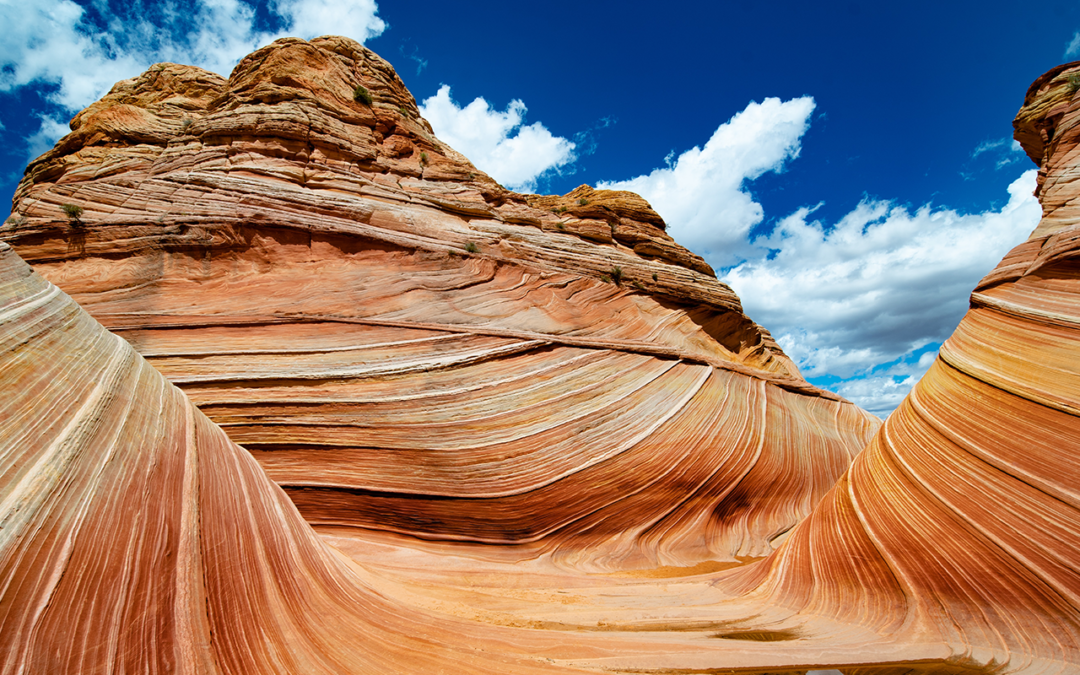
by The Goat | Mar 23, 2020 | Geology, The Wave, Vermillion Cliffs
How was The Wave Formed?
Hiking on the Colorado Plateau is a constant game of “how did this get here?” and “why does this look this way?”. Everywhere a hiker looks, they are confronted with wild rock formations, howling desert wilderness, and geology on a nearly incomprehensible scale. The mere presence of this place has led countless professional geologists and outdoor enthusiasts alike to spend lifetimes exploring the fabulous scenery and enormous scale. From Grand Canyon to The Arches, from Antelope Canyon to The Subway in Zion, the Colorado Plateau contains some of the most fantastic and intense scenery in the world.
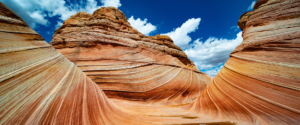
The Wave, in all of its glory
The Wave, however, is perhaps the single most-famous stand-alone feature in this wild landscape. Of course, the most often-asked question about The Wave (besides maybe how do I get a permit) is how was The Wave formed? The short answer: geology. The long answer, and the much more interesting one, begins nearly 200 million years ago. Let’s go time traveling!
The Jurassic: Wind-blown Sand Seas
The time is 180 million years ago. The place is at the southwestern margin of the supercontinent Pangea. All of Earth’s tectonic plates have assembled themselves into one, massive block of puzzle pieces. Dinosaurs roamed the landscape, but if you were standing here at the time, you would see very few living things. Here, you scramble to the top of 100 foot-high mountain of sand and gaze out over an unforgiving, desolate, and stark landscape. This is the birthplace of The Wave.
The landscape before you is thought to be the largest sand-dune desert in the history of the Earth, stretching hundreds of miles in each direction, from the ancient Pacific ocean in the west to modern-day New Mexico in the east; from modern-day Mexico in the south to what is now Wyoming in the north. Outside of the occasional desert oasis, this is a lifeless, hostile place. Trade winds blow massive amounts of sediment from the eroding Ancentral Rocky Mountains and the rising Appalachian Mountains southwest towards the ocean, forming monstrous sand dunes that migrate across the landscape like a giant game of Pac-Man, with dunes piling onto and devouring each other in the relentless winds.
As you stand upon this giant dune and wonder what is to become, you step into your time machine. Closing the door and making sure the windows are squeaky clean for maximum viewing, you begin your journey over the next 180 million years. Buckle up!
Burial, Cementing, and Uplift
Through your windows, you witness the close of the Jurassic, and the beginning of the Cretaceous. The climate cools and becomes wetter, ushering in a gradual but stark change in the environment. The Cretaceous Interior Seaway encroaches upon the land as the tectonic plates continue to shift, slowly breaking apart as Pangea slowly morphs into the modern map. The former sand dune upon which you stood sinks into the landscape and is buried by a warm sea bordered by humid swamps and yet more dunes.
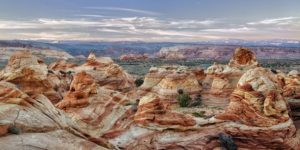
Panorama of scenes in the Vermillion Cliffs
To the west, the Pacific Tectonic plate pushes its neighbor, the Farallon Plate, under the North American Plate at a very low angle, giving rise to the Laramide Orogeny and modern-day Rocky Mountains. This uplift carries away the seas, and sets the stage for the modern landscape to emerge. In the distance, you see an intensely bright light in the sky, followed by an impact that is felt around the globe. An asteroid has pounded the Earth in what is now the Gulf of Mexico, ending the reign of the dinosaurs and the Cretaceous.
Oh, there is just one more thing….
The canvas upon which the landscape seen in photographs today is set for the artist of geologic time; erosion. However, before the final masterpiece is created there is one more incredibly important thing that must occur: the unique uplift of what will become the Colorado Plateau. As the Farallon Plate sinks into the mantle, it behaves in a peculiar manner. Typically, tectonic plates behave in a ductile manner as they are heated, flexing in a pliable way as they are resorbed into the mantle.
However, the Farallon Plate behaves in no such way. Instead of acting in a ductile manner, it behaves in a rigid, brittle manner; perhaps due to the low angle of subduction. A large piece breaks away from the whole, becomes buoyant, and is thrust back towards the surface. This piece of plate forces the surface above it to rise several thousand feet above sea level, and causes land to the west to begin extending back out to the west over the Pacific Plate. Here, on this uplifted and exposed surface is where the masterpiece will be painted.
Wind, Water, and Time
At this point, The landscape seems relatively flat and featureless. The Rockies loom on the eastern horizon, but the familiar modern landscape is buried under millions of years and thousands of feet of sediment accumulation. After all, the Navajo Sandstone is but one geologic unit and one small snapshot in time in a region that has been built quite literally one grain of sand/clay/lime at a time over nearly 550 million years.
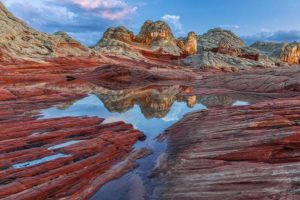
White Pockets, another wild landscape near The Wave in the Vermillion Cliffs
But, the stage has been set. The time has come. The sediment is deposited. The uplift has exposed it to the elements. Now the combined forces of wind, water, and time take their turn. We are in the Neogene period, about 20 million years ago. The Neogene period itself is not well represented by sediments or deposition on the Colorado Plateau.
Therefore, it is difficult to say precisely what environmental conditions existed. However, what we can say for certain is that, beginning in the Neogene, the Colorado Plateau began to undergo a sustained and intense period of erosion and deep dissection. This period continues to this day as the high plateau is exposed daily to the ravages of winds, pulsated by short periods of intense precipitation (rain and snowstorms). In addition, the general conditions of the desert make this place quite inhospitable to large and widespread plant life. This helps foster the erosive forces carving into the rocks, and leaves them uncovered for all to view in their splendor. Yay for us!
Okay, great. Get to the point!
You came here to know how The Wave was formed. Let’s talk about that! As discussed, numerous specific things had to occur for this feature to be created. All of those things have now happened, and we are ready to form The Wave. Strip away the overlying sediments, down into the sleeping Navajo Sandstone. Neogene period, got it. 15-20 million years ago, check. Erosion, check. But this feature, specifically?
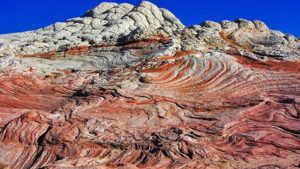
The nature of the Navajo Sandstone in Vermillion Cliffs
The Wave is the specific result of small trickles of water contouring their ways through the Navajo Sandstone, followed by long, sustained periods of wind. As we discussed, prior to deep dissection the area was a flat-ish, blank canvas. During periods of rain, water follows the path of least resistance due to gravity. This feature of water allows it to create “nickpoints”, or places that are routinely exposed to water flows and erode faster than areas where water does not flow. Yep, this all checks out. So what?
The Formation of The Wave
So what, you say? This is what. The Wave’s appearance began very carefully with small trickles of water cutting into one particular “nickpoint”. After water carved the niche, wind took over. From that small nickpoint, the wind howled though relentlessly over the many millions of years afterwards (15+ million). Punctuated by alternating winds and small trickles of water, The Wave was carefully and painstakingly carved from the sandstone. Surf’s up!
That’s how the feature itself was formed. A deeper question is this: why does it look this way? (with the waviness and lines?). Elementary, my Dear Watson! The Navajo Sandstone, of course! You see, as we’ve discussed, the Navajo Sandstone was deposited as large sand dunes. Sand dunes are formed by layers of sand piling upon one another, then avalanching down the front face as the dune migrates. The avalanches and migrations are preserved as wavy lines, revealing the internal structure of the dune. It is known in geologic terms as “planar-tabular cross bedding”.

Diagram of the formation of sand dunes, courtesy smallpond.ca
In effect, the dunes are waves, just made of sand instead of water. Therefore, The Wave is truly a “wave”; petrified waves of stone.
The Future of The Wave
The geologic processes that formed The Wave are, ironically, the same that will destroy it. Current geologic processes are exposing the Colorado Plateau to erosion. These processes are likely to continue into the near-term (several million years) geologic future barring some catastrophic event or sequence of events.
However, you can rest easy knowing that The Wave, along with most of our favorite features in canyon country are here to stay for the foreseeable human future. Enjoy!
Going Guided
Hiking and exploring The Wave located in Coyote Buttes in southern Utah and northern Arizona is an incredible experience. There are few hiking trails in the southwest that come close to the sheer awe that is induced while seeing The Wave for the first time. While securing permits can be a challenging affair, it’s totally worth it. Hiking The Wave is something everyone should experience in their lifetime.
Although it is possible to see these places yourself, hiring a guiding outfitter is a great idea. For instance, guiding services provide logistical support, and plan everything for your best possible trip. They provide a great safety net on the trail, and are trained in backcountry medicine. Above all, they provide a depth of knowledge of the region that turns a walk into a true adventure.
**Remember, you cannot hike or visit The Wave without a permit! Getting caught without a permit is a bad situation.**
Canyons and Chefs provides all of the support you need, and pairs that with professional chefs and expert geologist/guides. Our meals use fresh ingredients and are inspired by local farms, culture, and cuisine. We utilize a mobile professional kitchen as a backbone for cooking over the fire. Furthermore, we provide top-of-the-line gear and passion for the places we explore. In conclusion, you can see these wild places, but going with an outfitter can create an even more memorable experience. Don’t be shy, and call us!
Read our blog!
For adventure Chef-Driven Outdoor Experiences, see our epic tours in Grand Canyon, Utah, and Arizona!
Follow us on Facebook and Instagram
Explore Further, Be Wild, Eat Like Kings —
Canyons and Chefs

by The Goat | Aug 27, 2019 | Hiking, Permits, The Wave, Vermillion Cliffs
How Do I Win the Wave Lottery?
It is called “The Hardest Permit to Get in the USA” by Outside and Backpacker Magazines. Your chances stand at roughly 3% on any given day. People enter month after month for, in some cases, years before winning (if they ever do). No doubt that The Wave of the Vermillion Cliffs in Arizona is one of the most sought-after destinations in the southwest, and the BLM’s daily quota of just 20 visitors makes it a tough proposition. Is there a strategy that can be employed to increase your chances? We sent The Goat out to do a hard target investigation. This is what he found:

The Setup
In order to lend ourselves the best chances, we started by pegging dates that were during the week. We decided on having an average group size (4), and picking presumably less-popular times of the year. We divided our applications between the online lottery and the in-person lottery. The in-person lottery is held daily at the BLM office in Kanab, Utah. We had all four people in our “group” apply online, and sent one of our group to the in-person lottery. Our goal was to employ a “blanket” strategy to best monopolize our potential chances. We could also properly calculate what, if any, our success rate might be. Over the course of two months, we employed this strategy following these criteria, and logged our failures and successes.
The Online Lottery
The Wave’s online lottery is where this permit gets it ornery reputation. With the in-person lottery being highly inconvenient for the vast majority of applicants, this lottery is not far from playing the Powerball Jackpot and hoping to win even a modest prize. The BLM splits permits 10/10 for the online and in-person for 20 people each day, so you can imagine what your odds might be. It’s like elbowing through throngs of crazed teenage girls at an NSYNC concert circa 1997. To play this game of chance visit the BLM’s Wave Permit Page.
The In-Person Lottery
The Wave’s in-person lottery, though inconvenient for most, can give the applicant a slightly better chance. For our purposes, we camped near the BLM office and tried to be the first to the door at opening time (8:30am, 7 days a week). In-person permits are typically offered for the next day, although if permits were not filled they may issue you one for the same day.
Kanab Visitor Center in Kanab, UT 745 US-89, Kanab, UT 84741
Playing the Odds
Our success rate at the conclusion of our experiment was quite low, as expected, for the online lottery. Given the cost of the permit ($7/person if you win, with a non-refundable $5 application fee for each application), and the low chances of winning, this strategy is not so much a strategy as a commitment. We spent nearly $500 and obtained two permits for middle-of-the-week in late November, and one in early February. Our final odds of winning, given our failure vs. success rate was a paltry 10%. (20 application, 2 permits).
Though this is higher than the national average, this was our own success rate and not measured against all other applicants. We imagine that the advertised 4% success rate is perhaps even slightly higher than actual. That being said, the thrill of victory is tangible in the face of numerous defeats. Our testers literally cheered and danced when permits were issued. Worth the sacrifice!
On the flip side, the In-Person lottery yielded excellent success. Our employed strategy of having a camper near the BLM office paid off nearly 100% of the time. In fact, the only time it was not successful was when our camper slept through his alarm and ended up being buried in line. The trick to the in-person permit is this: one person may apply for one permit, regardless of group size (up to 10). For example, only three people may apply, but they may each have parties of 4 or more, meaning that only two groups would be successful, and only two people from the remaining group would be issued a permit. For fairness purposes, we gave our permits to those who were behind us. Pay it forward!
The Goat’s Conclusion
Hiking The Wave is a must for anyone interested in wild scenery, challenge, photography, and of course geology. Though winning a permit through The Wave lottery can be an adventure in and of itself, it is highly advisable to take the plunge. Persistence, perseverance, realistic expectations, and a disciplined system with a set budget will pay off eventually. If at all possible, the in-person lottery is absolutely the way to go. But, if this is not a possibility for you at all, you must bear the challenge of the online lottery, which even when employed with a strategy can be difficult to win.
How You Can Apply for Permits to The Wave
Permits to Coyote Buttes North (The Wave) and South are issued by lottery, both online and in-person as discussed. For Coyote Buttes North, the cost is $7/person on the permit, and for Coyote Buttes South the cost is $5/person. For other parts of the Vermillion Cliffs National Monument, as well as the Paria Canyon-Vermillion Cliffs Wilderness just to the north, permits are free and supplied at the trailheads of Wire Pass, White House, and for other areas such as White Pocket. Any overnight stay requires a backcountry permit, obtained either at the trailhead or the Kanab Visitor Center. Be advised there is no overnight camping allowed in the Coyote Buttes permit area.
Permits to The Wave can be applied for four months in advance of your requested date. You have an entire month to apply, and you can apply for up to three entry dates per application. If you are successful you will be authorized for one of the days. There is a non-refundable $5 fee to apply, and you will be notified of the first of the month via e-mail whether or not your application was successful.
Example
Let’s say you wanted to visit Coyote Buttes North (The Wave) in April. Here is the procedure you would follow.
1. Go to the Permit Page between Dec. 1 and Dec. 31.
2. Follow the directions, choosing up to three possible entry dates. If successful, you will only be authorized one date.
3. You will be notified via e-mail the first day in January whether your lottery application was successful or not.
4. After being notified, you will have 14 calendar days to pay for your permit. You can pay online with your credit card. Your e-mail notification will contain a link to a secure web page, where you can go to pay and submit the remainder of your trip information.
5. Your permit will be mailed to you four to six weeks after you have paid your fees, unless you chose the option to pick it up in Kanab, St. George, or the Paria Contact Station when you filled out your permit application.
The way the lottery works essentially nullifies any attempt to be an “early bird gets the worm” type of situation, and you have as good of a chance of winning the lottery regardless of your application date or time. Applications received in the month of April, for example, have equal chances of being selected for permits issued in August regardless of what day in April the application was received by the BLM.
Rules and Regulations
From time to time, people will ask us “can I go to The Wave without a permit?” The answer here is simply, NO. Your permit must be displayed visibly on your pack/person at all times, must account for all people in your group, be paid in full, and for the dates displayed on the permit. Violation of any of these will result in immediate ejection from Coyote Buttes, and a $1200/person fine. Multiple violations can result in lifetime bans, and even federal criminal trespassing charges. But what are the chances you’ll be caught in such a remote place? The Wave, while remote in terms of general ideal, is very popular and highly regulated.
The BLM devotes quite a bit of time and resources to The Wave for safety, environmental study, and conservation purposes. Though they are not “out to get you”, they will enforce regulations. The chances of having your hiking party interact with a BLM Ranger in the Coyote Buttes area is almost 100%. Please, please go through the permitting process. The more people that violate the regulations may result in stricter rules, less permits, and even a shutdown of the area altogether.
Safety and Transportation
Located adjacent to highway 89A near the Arizona/Utah border, The Vermillion Cliffs National Monument is one of the most spectacular, wild, and unspoiled places in the American Southwest. Consequently, it is a rugged place that can be difficult to navigate. Do not even consider visiting The Wave, or any other part of Vermillion Cliffs without 4WD (AWD is NOT 4WD), several detailed maps, a compass, GPS (not in-dash), and plenty of water. If heading to White Pocket or Coyote Buttes, be prepared to drive in sand, which can be very challenging if you have not done it before. Many a truck have been lampooned in the sands of Vermillion Cliffs.
Going Guided
So you’ve won the lottery, great job! Now you need to get there and enjoy this once-in-a-lifetime opportunity to its fullest extent. A guide can be an invaluable resource in a place like this, and there a no better than the geologist/guides of Blue Marble Adventure GeoTourism. We will help you plan your visit from start to finish and ensure that you see all the highlights of Vermillion Cliffs (more than just The Wave). After your epic adventure we get you back safe and sound, and guarantee an intensely special and memorable experience.
The Final Word
Everybody wants to go to The Wave and The Wave is absolutely worth the visit. It’s a right of passage for many world travelers and backcountry adventurers. However, the lottery and regulations can make it tough to see, particularly if the online lottery is your only possibility. Coyote Buttes South permits are somewhat easier permits to obtain, and still works on the calendar system, giving you the possibility of specifically choosing a date. Your chances are much higher (like 25% higher), and Coyote Buttes South has some astounding and gorgeous scenery.
White Pocket also is among the most fabulous places in the Southwest, and regarded by some as even more spectacular than The Wave and Coyote Buttes North. It only requires a day permit and has no lottery, making it highly accessible. Other areas of the Vermillion Cliffs such as Paria Canyon and the Buckskin Gulch are among the most excellent canyons in the world, with Buckskin Gulch in particular being regarded as the longest, deepest slot in the world. Whatever your choice, rest assured that just because you didn’t score that permit to The Wave you won’t be missing out on some of the best the American Southwest has to offer.
Going Guided
Hiking and exploring Vermillion Cliffs and The Wave is a special experience. Although it is possible to see these places yourself, hiring a guide is a great idea. For instance, guiding services provide logistical support, and plan everything for your best possible trip. They provide a great safety net on the trail, and are trained in backcountry medicine. Above all, they provide a depth of knowledge of the region that turns a walk into a true adventure.
Blue Marble Adventure GeoTourism provides all of the support you need, and pairs that with expert geologist/guides. Our backcountry meals use fresh ingredients, and are planned by a professional chef. Furthermore, we provide top-of-the-line gear and passion for the places we explore. In conclusion, you can visit wild places, but going with a guide can create an even more memorable experience. Don’t be shy, and call us!
Read our blog!
For adventure hiking vacations in a geologic time machine, see our epic tours in Grand Canyon, Utah, and Arizona!
For geological musings read The Goat’s geology blog.
Follow us on Facebookand Instagram
Explore Further, Be Wild, See Through Time — Blue Marble Adventure GeoTourism

by The Goat | Aug 27, 2019 | Arches, Backpacking, Bears Ears, Canyonlands, Geology, Grand Canyon, Grand Staircase-Escalante, Hiking, The Wave, Utah Canyon Country, Vermillion Cliffs
The Bucket List Countdown
Everyone has a list. A daily list, a chore list, a grocery list, an assignment list, a to do list, a list of…..? None of these lists are fun, nor do they really do anything to further joy and appreciation of the beauty of the natural world. This is where the bucket list comes in. A life to do list, a list of things that if we accomplished them we would pass into time and space as happy souls; souls that knew there was nothing more that they needed to accomplish. That, my friends, is the only to-do list that you should really pay any mind.
What we have here is the Top 10 places to see in the American Southwest before time and space claims you for their own. These 10 locations not only encompass everything that makes the Southwest special, but are places that fill us with wonder, joy, mystery, energy, beauty, and a sense of being that can only be achieved by realizing just how special a place our Earth is.
The foundational specialty of the top 10 is the mind-bending geologic scales that they present to us. This is not a comprehensive list but rather one compiled of The Goat’s personal tastes and experiences. Come along on a journey through time!
10. Glen Canyon National Recreation Area, Arizona
Glen Canyon National Recreation Area provides almost limitless opportunities to hike, backpack, boat, swim, and recreate (hence the name). Though much of its splendor has been covered by the waters of Lake Powell behind Glen Canyon Dam, the area remains a splendrous wonderland of rock and scenery. Coursing from the seasonally-populated town of Hite in the north to Glen Canyon Dam itself, GCNRA traverses a stark and beautiful land along the former path of the Colorado River.
Among these fabulous places are Coyote Gulch, Choprock and Neon Canyons, and West Canyon among others. These canyons in particular still display the outrageous scenery and fairy tale-esque environments that Glen Canyon held before being impounded by the “beavers”.
Slickrock country abounds here, with canyons carved into orange and red-hued Navajo Sandstone and the aptly-named Glen Canyon Group. The rocks here are of Jurassic age, and record tidal mud flats and incredibly vast wind-blown desert sand dunes, which is thought to be the largest desert in recorded geologic history.
The Goat’s advice: get off the lake and into the canyons if you truly want to see this fantastic place. The Canyons of the Escalante, part of the northwesterly arm that extends from the Colorado, holds many remnants of the entombed wonderland. However, many features (such as the famous Rainbow Bridge) can be reached by boat which is a fun way to see this stark rock paradise set against the blue waters of Lake Powell.

Main Attractions:
Deep, sinewy slickrock canyons replete with arches, natural bridges, waterfalls, ancient ruins, and Lake Powell.
How to Get There:
For the easiest lake access, head to the town of Page, Arizona and one of the many marinas. From nearly anywhere else along its boundaries in southern Utah, GCNRA can be accessed by foot via countless canyons.
Optimal Seasons:
Hiking in Glen Canyon is best enjoyed from March to June, and late September to November. Lake Powell is a wonderful summertime destination.
9. Bryce Canyon National Park
Set in south-central Utah, Bryce Canyon contains deeply carved amphitheaters and ubiquitous hoodoos draped in orange. Erosional remainders of ancient freshwater lakes, these hoodoos create a fairyland of rocks that is extraordinarily unique. Many of the hoodoos sit in deep basins that appear almost like large theaters, beckoning to audiences to watch their show.
Bryce Canyon checks in as one of the smaller National Parks at just over 50,000 acres, but contained within it is jaw-dropping scenery that will surprise and delight. Before you leave, you may feel as though you have 100,000 new hoodoo friends, as each one of them seems to take on a certain unique persona.
This area was covered by large, freshwater lakes in the Pleistocene between 8-10 million years ago. Regional tectonic uplift and and erosion by dripping water, wind, and time has sculpted this outstanding landscape.
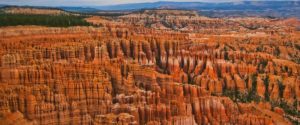
Main Attractions:
A veritable forest of the geologic oddity known as the hoodoo. The hoodoos here are erosional remains of once-cohesive blocks of sandy limestone that have been carved slowly by the forces of geologic time. Other features, such as spires and buttes, tower above the trails that snake their way through the golden-tinted hoodoos into secret grottos and cavernous alcoves. Truly stupendous!
How to Get There:
Take Utah Highway 12, a National Scenic Byway, south from Escalante, or north from Panguitch, Utah. The nearest major airport is in St. George, Utah, about 4 hours from the park.
Optimal Season:
The best season in Bryce Canyon is late spring to early fall, but winter brings snow and chilly weather.
8. Bears Ears National Monument, Utah
In the southeast corner of the state lies one of our newest National Monuments, Bears Ears. Conferred by President Barack Obama in December of 2016, the designation of Bears Ears has been a source of controversy and conflict. This controversy boiled into a nearly 85% reduction of the monument in 2017 by the current White House occupant, Donald Trump. The reduction is being litigated in Federal Court, and a final decision on the boundaries of Bears Ears awaits a judges gavel.
Bears Ears, named for twin buttes that stand sentinel over the 1.6-million acre Monument, is an absolute treasure trove of cultural, geologic, and ecological resources. Though its claim to fame are the thousands of ruins and relics left behind by generations of Anasazi Puebloans, the landscape itself is incredibly diverse and nearly unrivaled in its scenic value.
Bears Ears contains three distinct provinces: the lowlands of the Valley of the Gods, Cedar Mesa and its gashing Grand Gulch, and the Fable Plateau home of spectacular Dark Canyon and the famous Bears Ears. A short climb up the Bears Ears reveals sprawling views across much of the Grand Staircase to the southwest, north to the Canyonlands and the Orange Cliffs.
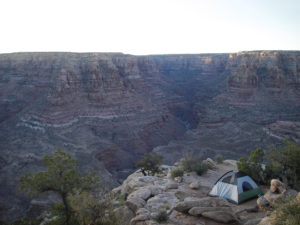
Valley of the Gods and San Juan River Country
Sitting at the base of Cedar Mesa and the historic Moki Dugway is the Valley of the Gods. Sometimes referred to as “Little Monument Valley”, Valley of the Gods is filled with large buttes and mesas sculpted into shapes that truly resemble sitting deities watching over their domain. Slightly to the southwest flows the San Juan River on its way to meet the Colorado River, goosenecking through the Monument Upwarp. The Upwarp is a massive wrinkle in Earth’s crust, remnant structure of the forces that built the Rocky Mountains. The core of this structure has been eroded and dissected, leaving the landscape beheld today.
Cedar Mesa
Up the Moki Dugway, a twisting, narrow “highway” climbing the sheer sandstone cliffs, sits Cedar Mesa. This is the most popular place in the Bears Ears, with many miles of well-trod trails into Grand Gulch, its canyon. Contained within Grand Gulch is the hundreds, if not thousands or ruin sites left by its former denizens, the Anasazi. The tribes abandoned the area under mysterious circumstances, leaving behind structures, petroglyphs, and pottery; many of these relics are in excellent condition.
The Fable Plateau
The final northernmost slice of Bears Ears is the Fable Plateau, a soaring mesa topping out at nearly 9000 feet. The mesa is carpeted with forests of aspens, fir trees, and wildflowers in the summer. Hidden in the back of beyond, a stunning landscape awaits.
Dark Canyon, perhaps America’s last wilderness frontier, is a little-explored and deep defile rivaling Grand Canyon in its scale and beauty. Sheer red and orange walls dive precipitously to its depths, where the narrows rarely see full sun; thus Dark Canyon. Revealed in this utterly surreal canyon is 100 million years of Earth’s history, recording sand-blown deserts to large rivers, and ancient seas that teemed with life. Set directly east of Canyonlands National Park, Dark Canyon is a hidden gem that rivals the most popular National Parks for scenery, and far surpasses them for wilderness solitude.
Main Attractions:
Bears Ears boasts looming buttes in the Valley of the Gods, ancient ruins in Grand Gulch, and wild, wooly, spectacular scenery in Dark Canyon. All of this can be see unencumbered and without a soul in sight.
How to Get There:
The small towns of Bluff and Blanding in Utah provide good jump-off points to the Fable Plateau and Cedar Mesa via Highway 95 west. valley of the Gods is best accessed by heading south from 95 down the Moki Dugway. The nearest airports are Grand Junction, Colorado or Flagstaff, Arizona.
Optimal Season:
Bears Ears can be enjoyed any time of year, but spring and fall are best. Summers are hot, but tolerable. Winters can bring snow to the Fable area, but is generally tolerable.
7. Waterpocket Fold, Capitol Reef National Park, Utah
The Colorado Plateau is a geologist’s paradise for several reasons. It is the preeminent showcase of relatively undisturbed sedimentary strata on the globe. Bound by mountains on all sides, including the mighty Rockies, The Plateau has somewhat mysteriously remained largely intact and undeformed since at least the Triassic, or roughly 250 million years. However, there are deformation structures within the province. The largest, most spectacular of these is a monocline known as The Waterpocket Fold in Capitol Reef National Park of Utah.
The Waterpocket Fold is a 100-mile long upwarp in the Earth’s crust, remnants of the powerful geologic forces that built the Rocky Mountains. These tectonic forces, known as the Laramide Orogeny, resulted in numerous monoclines, or single-flexure folds, across The Plateau. The Waterpocket Fold is by far the most impressive. To see this fold is to truly behold the power of Earth’s processes; those that can thrust mountains thousands of feet into the sky, and those that can bend hard rocks like silly putty.
The names of this surprising feature come from two histories:
The fold gets its name from the countless divots on its domed head that collect water after rain; thus water pockets. It is also called “Capitol Reef”: “Capitol” from the Navajo Sandstone domes resembling government buildings in Washington DC, and “Reef” from its standing as an incredibly formidable barrier to travel similar to coral reefs impeding boat travel in the ocean.
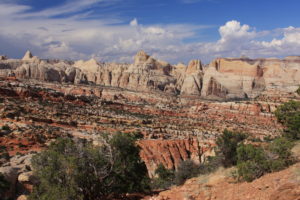
Main Attractions:
The Waterpocket Fold is the particular feature of interest in, or better yet is, the Capitol Reef. Within its impenetrable cliffs are arches, natural bridges, creeks with waterfalls, ruins, petroglyphs, deep canyons, and outstanding natural scenery. The fold gets its name from the countless divots on its domed head that collect water after rain; thus water pockets.
How to Get There:
Capitol Reef National Park is near the town of Fremont in central Utah. Highway 24 runs directly through the park.
Optimal Season:
Spring and fall are best, but Capitol Reef is nice any time of year. Summers are warm, but tolerable. Winter can bring snow and cold, although this brings intense beauty,
6. Zion National Park, Utah
How does one describe perhaps the most dramatic cliff and canyon topography on the planet? Try this: it’s like walking into the most dramatic cliff and canyon topography on the planet. The walls of Zion Canyon stretch up nearly 2000 feet over its floor. With its main access being from the bottom-up, very unique in the world of canyons, Zion presents an astonishing perspective that truly makes one feel minute. Zion owes its drama to (what else), its geology and the incredibly specific sequence of events that occurred.
What happened here?
Zion sits on the southwest margin of the Colorado Plateau Province, directly at its border with the Basin and Range Province. The Basin and Range is a vast area of the southwest from essentially Las Vegas down to Phoenix and out west to Los Angeles that has been subjected to extensional tectonics. That is, the crust is literally pulling itself apart like silly putty. Zion’s location is the reason for its existence. With the Basin and Range faulting and pulling downwards to the southwest, the Virgin River has been forced to flow out and down at a high rate while the margins of the Plateau “bounce” back up in buoyant resistance to the gravitational pull of the Basin and Range.
This dual-headed action has resulted in the extraordinary and incredibly dramatic landscape, and is also the reason that access is from the bottom instead of the top, like most canyons. Zion is an incredibly special place that presents a spectacle nearly unmatched on the planet. Why is it only #6 on this list, you ask? Crowds, plain and simple. Summer is when the throngs of people descend like locusts, when it’s over 100 degrees most days. Despite being one of the smaller National Parks, it receives roughly the same visitation as much larger parks like Grand Canyon, Yellowstone, and Yosemite. Ever tried to jam yourself into the crawlspace of your attic in the summer? Welcome to Zion! If you would truly like to enjoy this place fully, visit in the off-seasons such as spring or fall. Winter, when the cliffs are covered in snow, is particularly special.

Main Attractions:
Zion Canyon is the main attraction here, with massive, soaring walls of red-orange sandstone glowering down at the valleys below. “Yosemite Dressed in Red” also boasts arches, mesas, buttes, exhilarating cliff hiking, and in the northern Kolob Canyon part of the park, less crowds.
How to Get There:
Zion can be accessed easily from Las Vegas via I-15, which is partly why it’s so popular. The towns of Rockdale and Springdale are quaint, if not touristy, little towns right at the mouth of the canyon.
Optimal Season:
Summers are hot and crowded. Winter can be snowy and chilly, but drives away the crowds and drapes the red walls in crisp white. Spring and fall are the best seasons.
5. Arches National Park, Utah
Made famous in Edward Abbey’s classic Desert Solitaire, the Arches is an intensely special and truly one-of-a-kind place. Home to the largest concentration of natural rock arches in the world, Arches National Park is a stunning and mind-bending. Over 2000 arches have been discovered here, and more wait in the wilderness. The iconic symbol of Utah, if not the entire canyon country, is Delicate Arch. Presiding over a large amphitheater and framing the La Sal mountains to the east, Delicate Arch is truly magnificent.
Like most of the places on this list, Arches is the result of a very specific set of geologic events. First (and most importantly) vast deposits of salt were laid down as ancient seas filled and evaporated in ceaseless cycles of oscillating climate. Salt behaves strangely, not like other rocks as you might imagine. It “flows” when subjected to pressure, and deforms very easily. This deformation combined with upward flow has resulted in the incredibly and precisely sculpted arches, which would not exist without it.
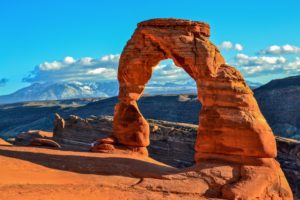
Main Attraction:
Simply put: the Arches. Arches National Park also contains other incredibly unique salt deformation structures such as domes, strike valleys, grabens, and undrinkable saline springs.
How to Get There:
The Arches are easily accessed from the town of Moab, Utah. Moab has an airport and many amenities like hotels, restaurants, and shops.
Optimal Season:
Avoid the summers, as it is interminably hot and crowded. Winter can be chilly, but Delicate Arch draped in snow is a sight to behold. Spring and fall are the best seasons.
4. Grand Staircase-Escalante National Monument, Utah and Arizona
A rose by any name is still a rose. Nowhere is this saying more true than at The Staircase, or The Escalante if you prefer. The scale and twisted geology of this place is almost overwhelming at times, and its remoteness only adds to its splendor. Despite having 1.3 millions acres contained within the monument, it only houses 15-20 developed trails. making backcountry travel and navigation skills a must to see much of the area. The Staircase is about as wild as it gets in the Lower 48.
Wild sandstone hoodoos, mesas, and almost hauntingly twisted sedimentary formations greet visitors at every turn. The sediments in the Grand Staircase, named for its star-step like appearance from afar, record geologic history from the Permian to the late Cretaceous, or about 175 million years.
Recently this monument has come under attack from the Trump “administration”. Like Bears Ears, the Grand Staircase has seen a reduction in its size by over 50%. Surprising to nobody, mining companies have moved in to claim areas once made off-limits by the monument. Contact us to find out how you can help this special place be saved.
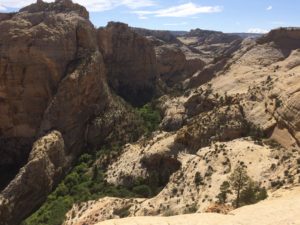
Main Attractions:
The Grand Staircase has it all. Here, explorers can find the heart of canyon country. From deeply-incised canyons to 10000 foot mountains, there is something for every adventure appetite here. Several new species of dinosaurs have been discovered here, as well as 650 species of bees, some endemic to GSENM.
How to Get There:
There are several points of access into the Grand Staircase. The town of Kanab, UT is the largest and provides the most amenities. The towns of Escalante and Boulder are classic canyon country towns. Page, AZ also offers good access.
Optimal Seasons:
There is a place for every season in the Grand Staircase, although summers are pretty warm. However, summer can be fabulous in the watery canyons, and cooling off under a showering spring is an excellent activity. Spring and fall are the best times to visit, and winter should probably be avoided.
3. Canyonlands National Park, Utah
This is where the canyon country puts on its grandest display. Canyonlands National Park can be described in one sentence: this place is nuts! From the Island in the Sky to The Needles to The Maze, Canyonlands forcefully makes a case for the most spectacular scenery on the planet.
This massive park, one of the largest in the National Park system, is divided into three distinct provinces. We’ll begin there.
Island in the Sky
This district is wonderful for first-time visitors to the park. It provides expansive views to the other two, more remote districts and contains many easily-explored and very famous features. Mesa Arch and Upheaval Dome are wonderful features to explore. Grandview Point elicits outstanding, sweeping views from atop vertical cliffs plunging 1000 feet straight down.
The Needles
The Needles District explores carefully-sculpted geologic features known as hoodoos. Cut into multi-hued Permian-aged (280Ma) rock, this district retains the distinct look of a giant pincushion. Hikers can approach the Colorado River from here via a few different, rugged trails.
The Maze
Perhaps the most remote place in the lower 48, The Maze is precisely what it sounds like. A dizzying network of canyons and rock, The Maze is reserved for the most adventurous canyon country explorers. Not to be missed here is the Chocolate Drops, the Alligators Teeth, and the Land of the Standing Rocks.
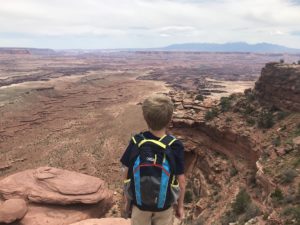
Main Attractions:
There are too many to list here. Canyonlands is impossible to experience in a day or two, especially with the incredible variation between the districts. The Maze is easily the least popular, and Island in the Sky the most popular. If you have one day, do overlooks at Island in the Sky. Upheaval Dome is also not to be missed.
The Needles contains outrageous arches and rock formations, though most are accessed by relatively long (4+ mile one-way) trails.
The Maze is the absolute definition of wilderness and requires commitment just to get there. Enjoy!
How to Get There:
The easiest access into Canyonlands is from Moab, UT. Moab provides access to Island in the Sky and the Needles. If you want to access The Maze, be prepared to drive for at least 3-4 hours over 4WD roads.
Optimal Season:
Spring and fall are the best seasons to visit the Canyonlands (noticing a pattern?). Island in the Sky can be a fine summer destination, but the Needles and Maze should be approached carefully. Winter can be a dramatically-fabulous time to visit, but stay out of the water.
2. Vermillion Cliffs National Monument, Arizona
Home to perhaps the most famous geologic formation in the world, Vermillion Cliffs is one of the most sought after destinations in the southwest. Known for its difficult access, remote location, and stunning geology, this is one place that cannot be missed.
Look at your screensaver right now. Pick up a postcard. There’s a good chance the picture on it is from the Vermillion Cliffs. The Wave, the most famous, graces much of the marketing material for the American Southwest.
How Was the Wave Formed?
Although it is named “The Wave”, water has little to do with this feature. It is carved in the Jurassic Navajo Sandstone, interpreted as a massive, Sahara-like desert. Wind, time, and small amounts of seaonally-flowing water has sculpted The Wave to its current beauty. Permits to see this feature can be hard to come by, but it is certainly worth the wait. Read our blog covering how to get permits to see this feature.
There are several other destinations here, however, including the longest, deepest slot canyon in the United States (Buckskin Gulch), the outstanding White Pocket, and Paria Canyon.

Main Attractions:
Nakedly exposed geology is on tap here, and The Wave itself, along with the mind-bending formations found all across this outstanding wilderness, are musts for anyone interested in beauty.
How to Get There:
Best access is from the towns of Page, AZ or Kanab, UT, but all access requires 4WD and knowledge of how to use it.
Optimal Season:
Spring and fall are the best times of the year to visit (once again). Summers are very hot, but if a permit to The Wave is involved the date on your permit is the optimal season. Winters are chilly and can bring snow, but also create rare and fantastic photo opportunities.
1. Grand Canyon National Park, Arizona
Truly the Grandaddy of them all, The Grand Canyon does and will always reign supreme as the jewel of the American Southwest. Overwhelming in its grandeur, humbling in its splendor, inspiring in its presence, this canyon is absolutely nothing short of grand.
There is very little to say about The Grand that has not been said in hyperbole for over 100 years. Teddy Roosevelt immediately designated it for protection shortly after his visit in 1904, and people have been coming in droves to gaze upon one of the official natural wonders of the world. Nearly 6 million people per year Grand Canyon, but it is not hard to find solitude on the trails and away from the busy parts of the park.
As one walks down the trails here, keep in mind that for each step is worth nearly 100,000 years. The rocks at the rim are roughly 260 million years old, and the rocks at the Colorado River in the inner gorge are roughly 1.9 billion years old. That means with 16,000 steps, you will have traveled 1.6 billion years back in time when you reach the river. Not bad for a day.
There is a lifetime’s worth of hikes, backpacking trips, and even scenic drives that await for the novice to the seasoned traveler. This is most certainly THE bucket list item.
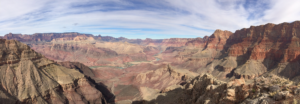
Main Attraction:
A giant freaking hole in the ground, but a ridiculously beautiful hole.
How to Get Here:
Access South Rim from Flagstaff or Tusayan, AZ, and access to North Rim is best from Kanab, UT or Jacob Lake, AZ.
Optimal Seasons:
Seasons vary depending on activity and location. Late spring to early fall are optimal times on both rims, but fall to spring is best for being in the Inner Gorge.
Going Guided
Oftentimes the best way to experience these nearly overwhelming places is on a guided tour. Guides provide several things: safety, security, logistics, transportation, food, water, and a depth of knowledge gained over years of experience in these wild lands.
Many of the places listed here require keen navigation skills, lack water, and can present difficult challenges with climate, wildlife, exposure to heights, and elevation changes. Hiring a guide can eliminate all of those potential issues, and allow guests to simply enjoy their surroundings. Blue Marble Adventure GeoTourism provides outstanding service, top-of-the-line-gear, professional geologist/guides, and handles all logistics. Guarantee your best trip ever! Go Guided!
The Goat’s Final Word
There it is, the best geologic adventures in the West. The naked rock wildernesses of the Colorado Plateau provide limitless and life-changing experiences. These 10 locations are not only the best adventures in the southwest, they represent some of the best adventure and scenery in the world.
The bottom line: immediately drop that foolish chore list you are holding and start dreaming beyond your gutters. The greater world waits for you, but don’t wait for it.
Like our blog? Check out one of our guided tours through geologic time to Grand Canyon, Utah Canyon Country, and Arizona Red Rock Country.
Explore Further, Be Wild, See Through Time — Blue Marble Adventure GeoTourism


















